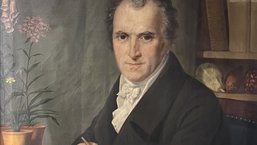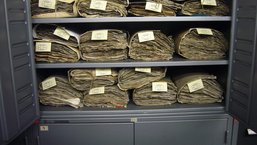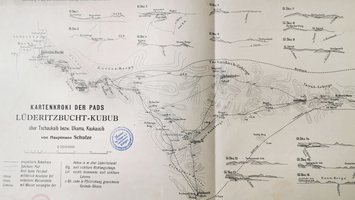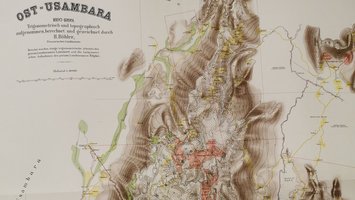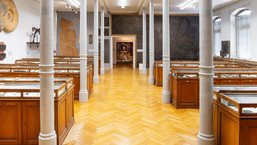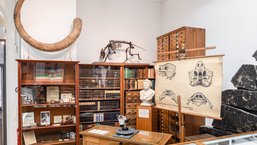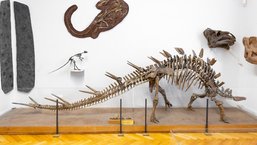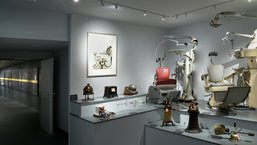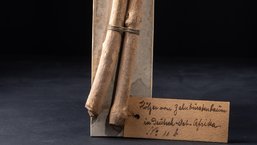Our Research
Provenance research at the MUT
The Museum of the University of Tübingen MUT comprises over 70 collections and 130 sub-collections, with extensive holdings from all faculties. Given the diversity of the collection holdings, questions arise about the history of the objects, their origin, previous changes of ownership, and how they were acquired. The colonial period is a key topic, as it sheds light on various collections whose objects were gathered from around the world due to the respective field of research.Provenance research is a relatively new discipline that examines the context in which objects were produced and passed on. It also investigates whether they may have entered European collections unlawfully. Researchers are interested in the objects' origins and 'biographies' – from creation to arrival in an archive, museum or university collection. This research presents and documents the perspectives of those involved.
Plant collecting has a long history in Tübingen. Founded by Hugo von Mohl in 1837, the Herbarium Tubingense preserves plant material from several centuries and from all over the world. It currently holds around 500,000 plant specimens and botanical objects. As well as flowering plants, these include fungi, algae, ferns, mosses, and lichens. The herbarium comprises a main collection and several special collections, including the renowned fruit and seed collection of Joseph Gärtner (1732–1791) and his son, Carl Friedrich Gärtner (1772–1850). Some of the approximately 600 specimens in this collection are preserved in cover glasses and were collected during adventurous journeys around the world by the likes of Joseph Banks, who participated in James Cook's first voyage to the South Pacific as a botanist between 1768 and 1771, and Carl Peter Thunberg, who travelled to South Africa, Java and Japan on behalf of the Dutch East India Company between 1772 and 1778. These two naturalists provided Joseph Gärtner with material from their collections for his descriptive work on the fruits and seeds of over 1,000 plant genera worldwide: 'De fructibus et seminibus plantarum'.
Address:
Herbarium Tubingense
Institute for Evolution and Ecology
Auf der Morgenstelle 5
D–72076 Tübingen
Opening hours:
The herbarium is not open to the public. Appointments are available by arrangement only.
Contact:
Prof. Dr Oliver Bossdorf
Send email
Tel.: +49 (0) 7071-2978809
Dr Uta Grünert
Send email
Tel.: +49 (0) 7071-2978812
The earliest known examples of simple cartographic representations of spatial relationships date back to the early history of Mesopotamia. The oldest surviving map is a clay tablet from the Akkadian city of Nuzi (present-day Iraq), dating from between 2340 and 2200 BC.
The Institute of Geography's map collection has existed since 1899, when it took over the holdings of the History Department. Originally compiled by the historian Dietrich Schäfer, the collection was subsequently expanded considerably through new acquisitions and war maps. Following the closure of the Geography Institute at the University of Stuttgart in 2010, its map collection was integrated into the Tübingen collection. This brought the total number of map sheets to around 160,000, as well as 600 wall maps and digital media. This includes maps from the colonial era which originally came from the Linden-Museum in Stuttgart. These maps are available for research purposes, including provenance research. Many valuable historical maps originate from the Middle East. These formed the basis of the Tübingen Atlas of the Middle East (TAVO), which was created between 1969 and 1993 as part of an interdisciplinary DFG special research area. The atlas comprises around 300 individual map sheets.
See also the overview of the available maps.
Address:
Map Collection Office
Geographisches Institut
Rümelinstraße 19–23
Room H601 (main building at Rümelinstraße 23)
Current opening hours:
See institute homepage
Other appointments by arrangement
Contact:
Dr Joachim Eberle
Send email
Tel: +49 (0) 7071-2973943
The Palaeontological Collection at the University of Tübingen has a history spanning more than 300 years. It originated from the natural history collection of Johann Georg Gmelin the Elder (1674–1728). The collections' size and quality were ensured by researchers and professors such as Friedrich August Quenstedt (1809–1889), Ernst von Koken (1860–1912) and Friedrich von Huene (1875–1969). The fossils are used for research, teaching and exhibition purposes. With over a million specimens, this university collection is one of the largest of its kind in the world.
Some of these witnesses to the geological past originate from Baden-Württemberg, such as the skeleton of a marine crocodile (Steneosaurus bollensis) from Heumaden, while others come from other parts of Germany, including the oldest fossil turtle, Proganochelys quenstedtii, from Neuenhaus. There are also examples from further afield, such as the Kentrosaurus from Tanzania. This dinosaur skeleton was discovered during an excavation between 1909 and 1913 on Tendaguru Hill in what was then German East Africa, now part of Tanzania. The excavation was led by the Berlin palaeontologist Werner Janensch (1878–1969). Edwin Hennig (1882–1977), an assistant in Berlin at the time, became director of the Tübingen Institute in 1917. It was through him that the skeleton was donated to the collection. Given the colonial context, questions arise about the circumstances surrounding the excavation: Were the people who dug up the bones paid, and were they aware of their value or significance? Did they agree to them being brought to Germany?
Address:
Palaeontological Collection | Department of Geosciences
Sigwartstraße 10
D–72076 Tübingen
Opening hours:
Monday to Friday, 9 a.m. to 5 p.m.
Guided tours:
Group and school tours at any time by appointment
Book a guided tour from our program or send us an email
Admission:
Free
Contact:
Dr Ingmar Werneburg
Send email
Tel.: +49 (0) 7071-2973068
The teaching collection of the Centre for Dental, Oral and Maxillofacial Medicine (ZZMK) originated from the personal collection of the dentist Hermann Peckert (1876–1940). Peckert founded the Dental Institute at the University of Tübingen and served as its director from 1910 to 1937. Since then, the collection has been expanded and is now housed on the ground floor of the dental clinic. The objects date from the 16th century to the present day.
A branch of a 'toothbrush tree' from the former German colony of East Africa (inv. no. UKT-Za-395) is a reminder of the colonial era. This instrument, used for cleaning and caring for teeth and known as a 'miswak' or 'siwak', was probably brought back from the former German colony by a missionary around 1910.
Address:
Dental Collection | Centre for Dental, Oral and Maxillofacial Medicine ZZMK
Osianderstraße 2–8
D–72076 Tübingen
Current opening hours:
By appointment/advance booking only.
Contact:
Dr Andreas Prutscher ZA
Send email
Tel.: +49 (0) 7071-2983461
Administration of the Museum of the University of Tübingen MUT
Send email
Tel.: +49 (0) 7071-2976437




